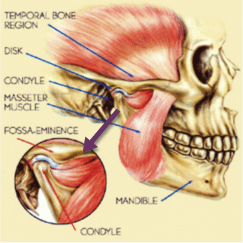The Temporomandibular Joint (TMJ) is a joint located on either side of the face in front of the ears and connects the jawbone (mandible) to the skull (temporal bone). It is one of the most complicated joints in the human body, providing not only rotational (pivoting) movement like all joints, but also a translational (sliding) movement. These characteristics are what allow the mouth to open wide and move the jaw from left to right. Between the top end of the jaw (condyle) and the socket into the skull, there is a disc of cartilage similar to the ones in the neck and back. These discs serve as shock absorbers, protecting the bones from hitting each other. In addition, the TMJ also depends on several muscles, such as the masseter muscle, for daily functions like chewing and talking. All these structures play an important role in supporting the TMJ, and if a problem arises in any of these areas, TMJ pain and dysfunction may occur. The conditions that affect the TMJ are broadly classified as Temporomandibular Joint Disorders (TMD).
 THE TEMPOROMADIBULAR JOINT
THE TEMPOROMADIBULAR JOINT
Important anatomical features of the TMJ :
- Condyle: rounded top end of the jaw bone
- Disk: cushion for the joint during
The TMJ is also dependent on the proper function of surrounding muscles and tissues, such as the masseter muscle that is responsible for chewing and talking. A problem in any of these structures could cause TMJ discomfort.
WHAT ARE SOME SYMPTOMS OF TMD?
A patient with TMD may experience one or more of the following symptoms:
- Headaches
- Teeth that do not meet properly
- Dizziness
- Difficulty chewing or swallowing
- Ringing or stiffness in the ears
- Pain or pressure behind the eyes
- Shoulder stiffness
- Facial pain
- Limited opening of the jaw
- Jaw clicking or pain
- Jaw going to one side upon opening
- Neck pain
- Tingling or numbness in the arms
- Teeth sensitivity to cold
WHAT CAN CAUSE TMJ PAIN?
- Trauma to the joints
- Cartilage wear and tear
- Dislocated disc
- Clenching and grinding
- Arthritis
- Myofascial dysfunction
- MVA (Motor Vehicle Accident)
Temporomandibular Joint Disorder (TMD/ TMJ) can be difficult to diagnose and treat, which is why it is imperative to visit a dentist with a postgraduate training in these disorders. Typically, many dentists only take a “two week crash course” in diagnosing TMD and learning the associated treatment methods. Unfortunately, this level of education is often not enough; patients many times have an acute form of the condition, which results from not receiving treatment in a timely fashion. This could be due in large part to the fact that patients who suffer from this disorder typically visit too many health care professionals, all of whom may only have one piece of the complicated puzzle.
When treating TMD patients and explaining all the symptoms, they are often times shocked to hear that the eyes, mouth, throat, ears, jaw, and neck are all associated with TMJ disorder. It is important to note that problems with the functioning of the temporomandibular joint affect overall health and well being, due to the intricate structures involved with this joint. Since individual TMD cases can be complicated, it is crucial to be screened, diagnosed, and treated by a dentist specifically trained and experienced in temporomandibular joint disorders.


